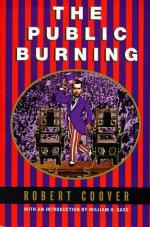|
This section contains 7,132 words (approx. 24 pages at 300 words per page) |

|
SOURCE: Walsh, Richard. “Narrative Inscription, History, and the Reader in Robert Coover's The Public Burning.” Studies in the Novel 25, no. 3 (fall 1993): 332–46.
In the following essay, Walsh examines Coover's reinterpretation of the Rosenberg trial and McCarthy-era hysteria in The Public Burning, arguing that the novel's carnivalesque satire—particularly as embodied in the Nixon and Uncle Sam characters—dramatizes the collective psychology of Cold War American society.
Robert Coover, one of the most impressive of the postmodern American novelists, established in his early fiction a preoccupation with the ways our various explanatory narratives impose upon the truth of our experience. His exploration of these ideas was at its most abstract and metafictional in the stories of Pricksongs and Descants (1969); but his major novel The Public Burning (1977), about the Rosenberg executions and the climate of McCarthyism in which they occurred, gave the same concerns a hard political edge. The novel displayed...
|
This section contains 7,132 words (approx. 24 pages at 300 words per page) |

|


